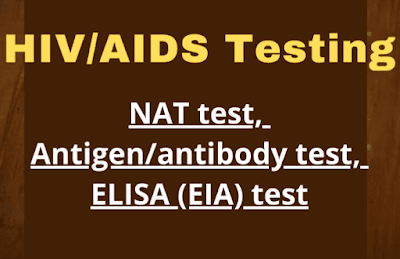Types of HIV Diagnostic Tests There are three types of HIV tests available- 1. Nucleic acid tests (NAT)2. Antigen/antibody tests – If you have HIV, an antigen called p24 is produced even before antibodies develop.3. Antibody tests – ELISA (EIA) and Western Blot

Know the modes of transmission of HIV/AIDS and incubation period, sign and symptoms of HIV/AIDS.
HIV tests are typically performed on blood or oral fluid.
1. Nucleic acid tests (NAT)
Collect sample – blood from a vein
NAT lab test is blood tests used to detect the genetic material of viruses and bacteria blood. It detects the actual virus in the blood. HIV RNA tests is done to detects HIV’s genetic material. The test report can tell if a person has HIV and how much virus is present in the blood (known as an HIV viral load test). The test results may take several days to be available.
A nucleic acid test (NAT) can usually provide information if have HIV infection 10 to 33 days after an exposure.
2. Antigen/antibody test
Collect sample – blood from a vein
An antigen/antibody lab test looks for both HIV antibodies and antigens present in blood. Antibodies are produced by immune system when exposed to viruses such as HIV. Antigens are foreign substances that cause immune system to activate against it.
If individual have HIV, an antigen called p24 is produced even before antibodies develop. The test results may take several days to be available.
There is also a rapid antigen/antibody test available that is done with a finger prick and results take 30 minutes or less.
An antigen/antibody test – Laboratory test on blood from a vein can usually detect HIV infection 18 to 45 days after an exposure to virus .
Antigen/ antibody tests done from a finger prick blood can take longer to detect HIV (18 to 90 days after an exposure).
3. Antibody tests
Collect sample – blood from a vein, oral fluid
HIV antibody lab tests only look for antibodies to HIV infection in blood or oral fluid.
Antibody tests that can detect HIV infection after an exposure, Tests can be done with blood from a finger prick or with oral fluid.
Most rapid tests and the only approved HIV self-test are antibody tests.
With a rapid antibody screening test, usually done from a finger prick blood or with oral fluid, results are ready in 30 minutes or less.
The oral fluid antibody self-test tell results within 20 minutes.
Antibody (Serology) tests – To detect HIV infection can take 23 to 90 days after an exposure.
Note – No HIV test can detect HIV immediately after the infection. If getting exposed by HIV infection in the last 72 hours, contact to health care provider about post-exposure prophylaxis (PEP), immediately.
If get an HIV test after a potential HIV exposure and the HIV test result is negative, get tested again after the window period.
Remember, Test Results HIV-negative if-
1. Done recent test is after the window period.
2. If hasn’t had a potential HIV exposure during the window period. If have a potential HIV exposure, then need to be retested.
HIV Negative Test Result
A HIV negative result doesn’t necessarily mean that don’t have HIV. This is due to the window period.
If retest again after the window period, have no possible HIV exposure during the window period, and the result comes back negative, then do not have HIV.
If any people sexually active or use needles to inject drugs, continue to take measures to prevent HIV, taking medicines to prevent HIV if at high risk.
HIV Positive Test Result
If use any type of antibody test and have a positive result, need to another (follow-up) test to confirm HIV results.
If the follow-up test is also positive, it means that have HIV infection.
Being HIV-positive does not mean have AIDS. HIV can lead to AIDS and most advanced stage of HIV disease. If a person does not get treatment or medical care HIV can progress into AIDS
But if a person with HIV takes their HIV medicine as prescribed, they may stay healthy lives, and may never be diagnosed with AIDS.
Diagnosed with HIV, Now it is mandatory that start medical care, taking prescribed HIV medicine and begins HIV treatment as soon as.
1. Antiretroviral therapy or ART (drug to treat HIV infection) is recommended for people with HIV to treat HIV.
2. HIV medication works by lowering the amount of HIV virus in body to very low levels. HIV drug can make the HIV viral load so low that a test cannot detect it (called an undetectable viral load) and can stay healthy lives. Having an undetectable viral load result also helps prevent transmitting the HIV virus to others.
3. HIV medication slows the progression of HIV and helps protect immune system, increase level of CD4 cells. For example, if have an undetectable viral load, effectively no risk of transmitting HIV to an HIV-negative people.


